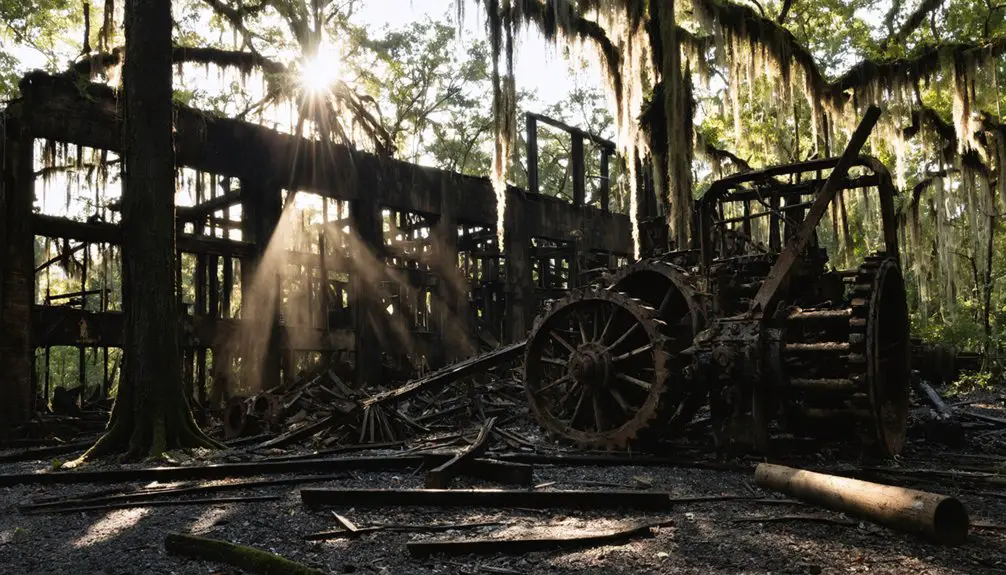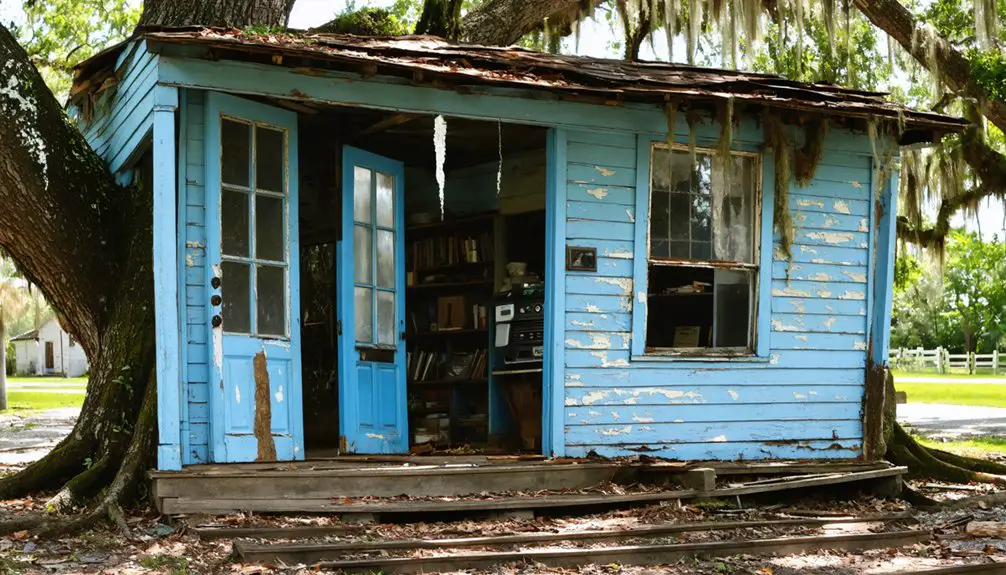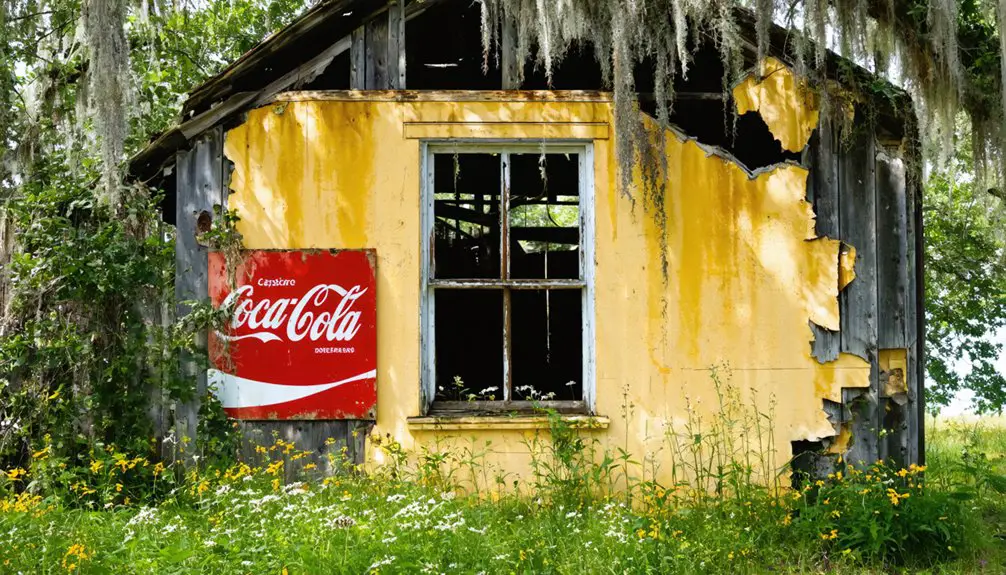You’ll discover Sampson City’s haunting remains southwest of Starke, Florida, where Colonel C.L. Peek‘s ambitious 1800s frontier settlement once thrived near Lake Sampson. The town flourished briefly with a bustling sawmill and railway connection, but faced devastating setbacks from the Great Fire of 1898, environmental challenges, and economic decline. Today, you can explore the surviving Sampson City Baptist Church, Church of God, old railroad grade, and scattered foundation ruins amid the encroaching Florida wilderness.
Key Takeaways
- Sampson City, established in the late 1800s by Colonel C.L. Peek, is now a ghost town southwest of Starke, Florida.
- The town’s decline began after the devastating 1898 Great Fire, which destroyed millions of acres of pine forests.
- Only the Sampson City Baptist Church, Church of God, and remnants of the Peggy railroad line remain visible today.
- Economic pressures, agricultural crises, and natural disasters in the 1920s forced many residents to abandon the settlement.
- The ghost town site features foundation ruins near Lake Sampson, though dense vegetation and unstable structures make exploration challenging.
The Vision of Colonel C.L. Peek
Colonel C.L. Peek envisioned transforming the wild frontier near Sampson Lake into a thriving settlement during the late 1800s. His ambitious plan centered on draining the surrounding swampland to create usable land for agriculture and development – a bold example of environmental engineering typical of Florida’s expansion era.
You’ll find Colonel Peek’s ambitions reflected in his strategic approach to community planning. He marketed the potential of these reclaimed lands to attract settlers and investors, positioning Sampson City as a promising real estate opportunity. Like the progressive physicians of Sampson County who guided their communities beyond medical care, Peek aimed to shape the social and economic fabric of the region.
Through extensive drainage projects, he sought to convert mosquito-laden wetlands into productive farmland while establishing transportation routes to support growth. His development model aligned with Florida’s broader land boom, demonstrating the era’s spirit of transforming natural landscapes into planned communities ripe for economic prosperity. Today, the area stands as a historical ghost town, drawing visitors curious about its past.
Early Days of Settlement and Growth
You’ll find Colonel C.L. Peek’s ambitious town vision taking shape through his establishment of a bustling sawmill operation that drew the first pioneer families to Sampson City.
Like Augustine’s father Patricius Aurelius, early settlers passed on strong civic traditions to build lasting foundations for future generations.
Much like Spain’s first settlement in St. Augustine, Sampson City’s founders aimed to build a permanent commercial presence rather than seeking quick riches.
The sawmill’s promise of steady work, combined with the area’s agricultural potential, attracted settlers who built homesteads and farmed the surrounding land.
Railroad access strengthened the fledgling community’s connections to broader markets, while the timber industry provided the economic foundation for early growth.
Colonel Peek’s Town Vision
In the late 1800s, a bold vision for a new Florida settlement emerged when real estate developer C.L. Peek set his sights on transforming swampland near Sampson Lake into a thriving community.
His ambitious plan included draining wetlands to create habitable spaces and establishing town infrastructure that would capitalize on emerging transportation opportunities. Like the International Load Lines regulations of later years, Peek’s development had to carefully consider water management and safety standards. Similar to frontier pioneers like Thomas Joseph Adams who settled new territories in Florida, Peek aimed to establish a sustainable community.
- You’ll find Peek’s strategy centered on the “Peggy” railroad line, which he secured to run through the heart of his development, competing with the CSX line for regional dominance.
- He transformed the landscape by converting swampland into farmable terrain, making it accessible by two-wheel drive vehicles.
- His development plan aimed to attract settlers by promoting both agricultural potential and railway connectivity, promising economic freedom in Florida’s frontier.
Sawmill Drives Pioneer Settlement
Sawmill operations powered Sampson City’s transformation from untamed wilderness to a bustling pioneer settlement. You’d have found the mill strategically positioned near dense virgin pine forests, where steam-powered sawmill technologies efficiently converted raw timber into valuable lumber.
The mill attracted workers and their families, who built homes and businesses nearby, creating a thriving lumber economy that wasn’t solely dependent on farming. Like the early Spanish explorers who first ventured into Florida’s wilderness, these settlers were pioneering new territory.
As you explored the settlement, you’d have noticed how the sawmill shaped the community’s growth. Settlers clustered around the mill for easy access to building materials and jobs.
The abundance of locally processed lumber meant you could quickly construct homes, barns, churches, and schools. This infrastructure development established Sampson City as a recognizable hub within Florida’s pioneer networks.
The Mighty Sawmill Era
When Joseph Forsyth partnered with Andrew and Ezekiel Simpson in the 1830s, they established one of West Florida’s pioneering sawmills near Pensacola, marking the beginning of a transformative industrial era.
Their Arcadia sawmill revolutionized lumber production, evolving from water-powered operations to steam engines and circular saws that boosted output to 900,000 board feet annually by the late 1830s.
Their operation produced an impressive 250,000 board feet each year during its early development.
You’ll find these technological advancements transformed the region’s timber industry through:
- Integration of steam-powered machinery that fueled unprecedented production levels
- Development of mule railroads and log flumes that solved critical transportation challenges
- Creation of complete industrial complexes featuring quarries, tanneries, and gristmills
The sawmill’s success attracted industrial pioneers who established complex supply chains, making Florida’s panhandle a competitive force in the nation’s timber market.
Workers faced demanding conditions, often paid in company tokens while handling dangerous steam-driven equipment.
The mill initially operated with forty slave laborers who were skilled workers purchased from Virginia.
Natural Challenges and Environmental Impact
Natural forces waged a constant battle against Sampson City’s development, as Florida’s subtropical climate and unique ecological pressures shaped the town’s eventual decline.
You’ll find evidence of natural reclamation throughout the area, where dense saw palmettos, scrub pines, and mangroves have steadily engulfed abandoned structures.
The town’s early decision to drain the adjacent Sampson Lake swampland proved disastrous, disrupting local hydrology and increasing flood risks. Similar to Hyde Park, Georgia, the area’s soil contamination levels contributed significantly to public health concerns and population decline.
Pollution impacts from nearby industries, including manufacturing and meat processing, have left lasting contamination in the soil and water.
The devastating “Big Freeze” of 1894-1895 dealt a final blow to the struggling settlement, while ongoing challenges from humidity, hurricanes, and wildlife continued to threaten any chances of recovery.
The Great Fire of 1898

While environmental challenges steadily eroded Sampson City’s significance, a catastrophic event in 1898 would accelerate its demise.
On February 16th, amid severe drought conditions, the Great Fire tore through the region’s essential pine forests, devastating an estimated 3 million acres across the Southeast. You’d have witnessed the destruction of critical tar kilns and turpentine stills that were the lifeblood of local industry.
The fire aftermath left an indelible mark on Sampson City’s future:
- Fourteen lives were lost in the disaster, forcing many families to evacuate
- The naval stores industry, central to the town’s economy, suffered extensive damage
- Economic recovery proved impossible as the destroyed Longleaf pine forests, crucial for tar and turpentine production, would take decades to regenerate
Economic Struggles and Population Decline
Following the devastating 1898 fire, Sampson City faced mounting economic pressures that would ultimately seal its fate.
The town’s economic resilience was severely tested as Florida’s agricultural crisis unfolded in the late 1920s, with the Mediterranean fruit fly destroying 60% of citrus production. You’d have seen the devastating impact of back-to-back hurricanes in 1926 and 1928, which battered the region’s already fragile infrastructure.
Rural revitalization became nearly impossible as young workers fled, creating a downward spiral of diminishing services and opportunities.
The town’s dependence on agriculture proved fatal when state quarantines restricted commerce, while New Deal programs largely bypassed small communities like Sampson City.
Without reliable transportation links and facing continuous disinvestment, the once-promising settlement gradually slipped into obscurity by mid-century.
Legacy in Local History

Today, you’ll find Sampson City’s physical remnants largely scattered and at risk, with only a few original structures and railroad artifacts remaining to tell its story.
Local historians and collectors work to preserve the town’s memory through documentation of oral histories, photographs, and artifacts that capture its late 19th-century origins and eventual decline.
While modern development threatens what’s left of this historic ghost town, its legacy endures through these preservation efforts and its role in Bradford County’s broader historical narrative.
Historical Preservation Challenges
Despite its historical significance, Sampson City faces mounting preservation challenges that threaten to erase its remaining physical legacy.
You’ll find preservation strategies severely hampered by decades of infrastructure decay, economic decline, and environmental threats. The town’s historical structures continue deteriorating while funding challenges limit conservation efforts, complicated by the absence of formal protective status and scarce documentation.
- Natural disasters have taken their toll, from the devastating 1898 sawmill fire to recurring floods that undermine remaining structures.
- Modern development pressures from expanding cities like Palm Coast threaten to replace ghost town remnants with suburban sprawl.
- Limited historical records and archaeological assessments make it difficult to prioritize which elements of Sampson City’s heritage deserve immediate protection.
Community Memory Impact
While Sampson City’s physical structures have largely vanished, its legacy endures through a rich tapestry of local historical narratives and cultural touchstones.
You’ll find the town’s impact woven into community narratives through the achievements of Major League Baseball player Herb Thomas and the pivotal role of the “Peggy” railroad line in regional development.
The town’s establishment by Col. C.L. Peek and the dramatic effects of the 1894-1895 “Big Freeze” remain central to local storytelling.
Through oral histories passed down by descendants, you’ll discover how the draining of Sampson Lake swamp and subsequent settlement efforts shaped the area’s development.
These cultural heritage elements continue to inform discussions about Florida’s rural settlement patterns and the boom-bust cycles that defined many early communities.
Exploring the Ruins Today
Located southwest of Starke, Florida, the remnants of Sampson City offer visitors an accessible window into Florida’s pioneer past.
Journey back to Florida’s pioneer roots through the accessible remnants of Sampson City, a weathered time capsule near Starke.
You’ll find ghostly remnants scattered across the landscape, where timber operations and natural decay have slowly reclaimed many historical structures. The site remains accessible year-round via 2WD roads, making historical exploration straightforward for curious adventurers.
- Visit the still-standing Sampson City Baptist Church and Church of God, which serve as key landmarks amid the ruins.
- Follow the old railroad grade where the Peggy line once ran, revealing traces of the town’s economic heritage.
- Explore foundation ruins and scattered artifacts near Lake Sampson, but watch for unstable structures and dense vegetation.
Exercise caution during your visit, as these unprotected ruins continue to deteriorate without formal preservation efforts.
Frequently Asked Questions
What Was the Peak Population of Sampson City During Its Most Prosperous Years?
Like a mystery lost to time, you’d find the town’s historical significance points to a peak population growth between several hundred to possibly 2,000 residents during its early 1900s prosperity.
Were There Any Notable Crimes or Lawlessness Incidents in Sampson City?
You won’t find any documented crimes or notable lawlessness in the town’s crime history. Available records show no significant law enforcement interventions were needed during the community’s short-lived existence.
What Happened to the Original Residents After They Left Sampson City?
While some stayed scattered near the ruins, most relocation stories show you’d find these residents building new lives in growing cities like Starke, where they sought better economic opportunities and improved living conditions.
Did Any Other Industries Besides Timber Try to Establish in Sampson City?
You’ll find evidence of limited farming efforts in the region, and while naval stores played a role nearby, there’s no solid proof of mining attempts or other industries succeeding in Sampson City itself.
Are There Any Surviving Photographs of Sampson City During Its Active Years?
You’ll find very limited historical documentation and photographic evidence of the active years. Your best chance is checking railroad archives, as they might contain rare images along their routes.
References
- https://www.tiktok.com/@socialshepherdadventures/video/7342301852702100778
- https://www.theroute-66.com/sampson.html
- https://www.ghosttowns.com/states/fl/sampsoncity.html
- https://www.youtube.com/watch?v=tdDq9mF-IxU
- https://en.wikipedia.org/wiki/List_of_ghost_towns_in_Florida
- https://stars.library.ucf.edu/cgi/viewcontent.cgi?article=1183&context=fhq
- https://digital.lib.ecu.edu/17036
- https://www.usmcu.edu/Portals/218/VN Oral History Catalog_1.pdf
- https://ufdcimages.uflib.ufl.edu/UF/00/02/77/95/02252/00362.txt
- https://www.smithsonianmag.com/travel/us-oldest-city-st-augustine-florida-180956434/



